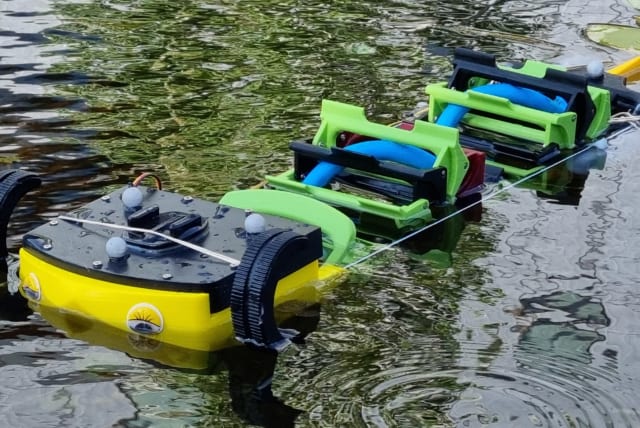Ben-Gurion University engineers develop one of the most efficient amphibious robots

Powered by a single motor, the robot's movement mirrors the way flippers move in water and centipedes move on land.
One of the fastest and most efficient amphibious robots – with potential applications in search and rescue, especially during natural disasters such as floods and tsunamis – has been developed by engineers at Ben-Gurion University (BGU) of the Negev in Beersheba. Called AmphiSAW, it also has potential applications in marine agriculture and fish feeding, as the robot attracts fish instead of repelling them.
Dr. David Zarrouk, the director of the Bioinspired and Medical Robotics Lab and his student Omer Guetta, developed the robot, whose movement in water was inspired by the movement of flippers and its land movements by centipedes. Dan Shachaf and Rotem Katz also contributed to the project. Their findings have been published in the peer-reviewed journal Bioinspiration & Biomimetics in an article entitled “A novel wave-like crawling robot has excellent swimming capabilities.”
Amphibians can live on land and in the water. The most common amphibious animals are snakes, salamanders and frogs. Their dual habitat increases their ability to capture prey – primarily slow-moving animals – and offers protection against predators.
Although crawling and swimming are antithetic capabilities in terms of performance, some amphibians such as salamanders and snakes are excellent swimmers; however, they cannot equal the performance of the fastest fish. Multiple animals ranging from micro-meter-scale bacteria to meter-scale vertebrates rely on undulatory motion to propel themselves on land and in the water. While undulatory motion can be used for both crawling and swimming, it requires the coordination of multiple joints, so only a few robots have the ability to mimic this motion.
Limitations of bio-inspired robots
While bio-inspired robots have continued to close the gap, they are still unable to match the performance in terms of speed, energy efficiency and coordinated movement of their biological counterparts,” the BGU team wrote. “One of the key limitations of the robots is that they generally rely on a large number of actuators which require complex control and require continuous maintenance. They may also produce pollution to the environment and noise and water-surface ripples that can intimidate animals. Moreover, most of the current designs are energy consuming and require complex control,” they wrote.
Many of the existing robots still rely on external tethers that limit their usage in real-life applications. Their moving speed on land and/or in the water remains low and many robots are unable to transition between land to water and vice versa.
Whether on land or in the water, the robot moves quite quickly. On land, the robot crawled at 1.5 body lengths per second (B/s) and swam at 0.74 B/s. It can be outfitted with legs or wheels at the front that increases its crawl speed, especially over uneven terrain. “The single motor and bioinspired design contribute significantly to the robot’s efficiency and the relative simplicity of its design means it is scalable to any size,” Zarrouk explained. His research goal is to produce robots that can complete complex maneuvers yet use very little power to run and are straightforward to produce.
Jerusalem Post Store
`; document.getElementById("linkPremium").innerHTML = cont; var divWithLink = document.getElementById("premium-link"); if (divWithLink !== null && divWithLink !== 'undefined') { divWithLink.style.border = "solid 1px #cb0f3e"; divWithLink.style.textAlign = "center"; divWithLink.style.marginBottom = "15px"; divWithLink.style.marginTop = "15px"; divWithLink.style.width = "100%"; divWithLink.style.backgroundColor = "#122952"; divWithLink.style.color = "#ffffff"; divWithLink.style.lineHeight = "1.5"; } } (function (v, i) { });


